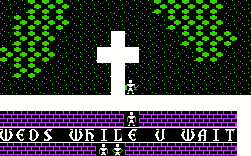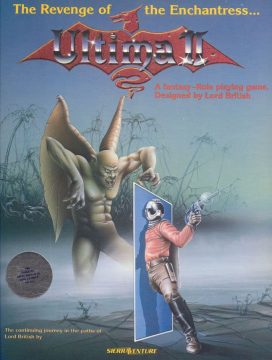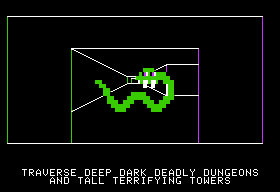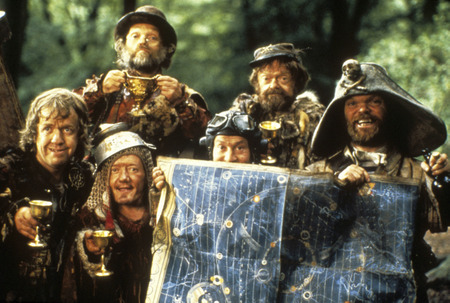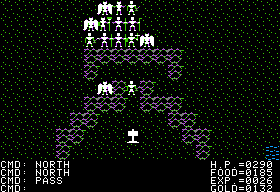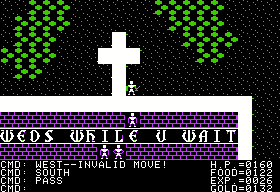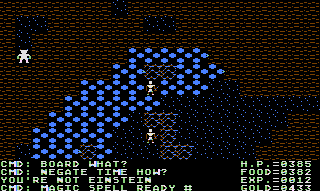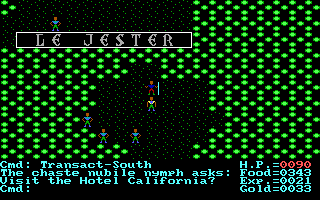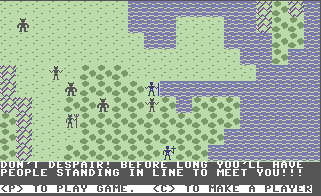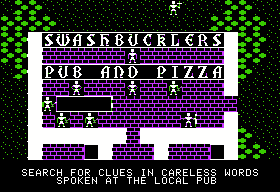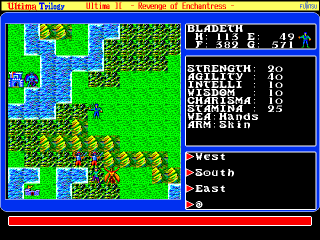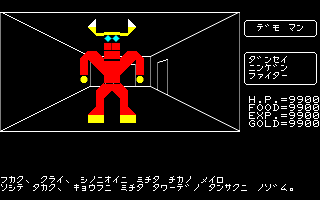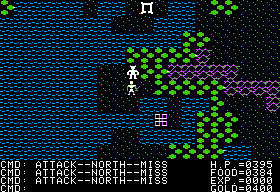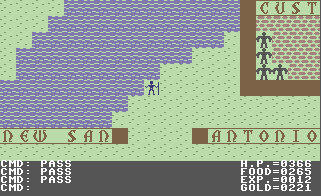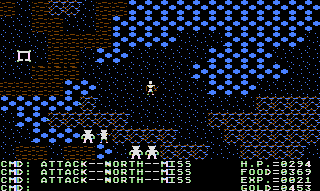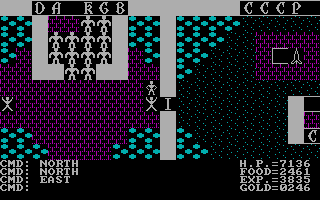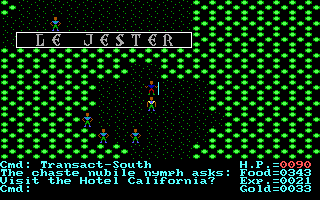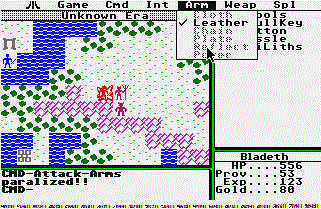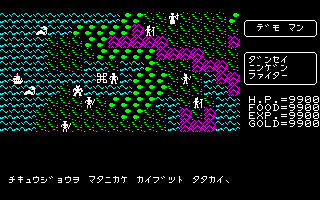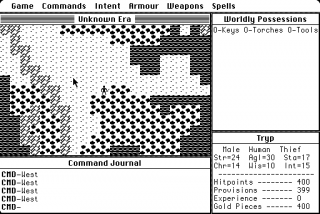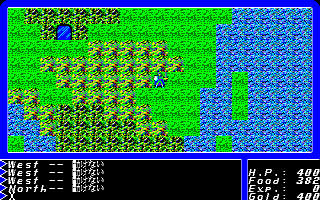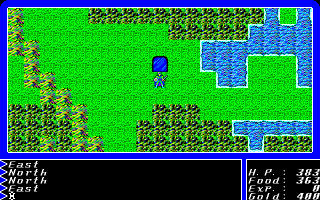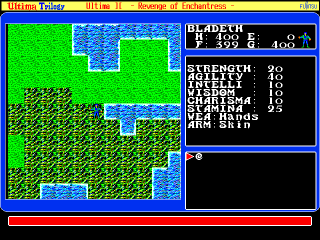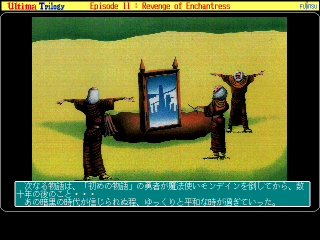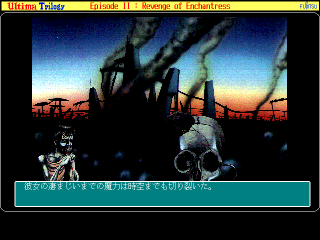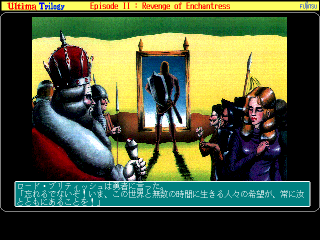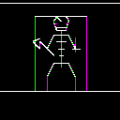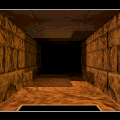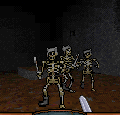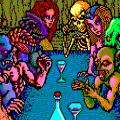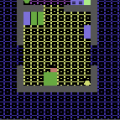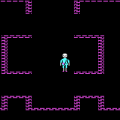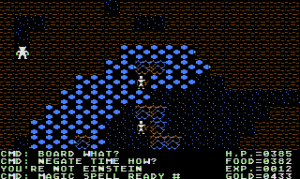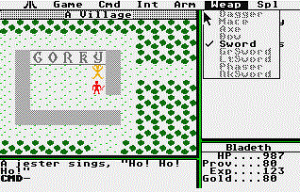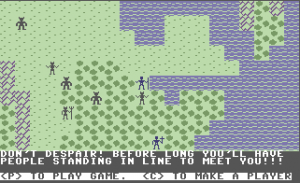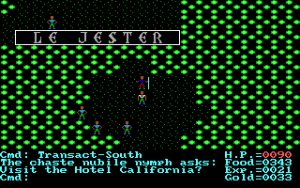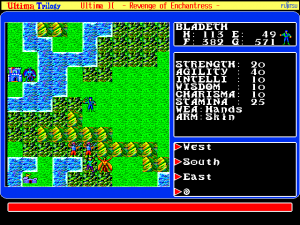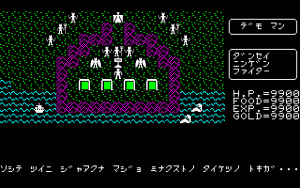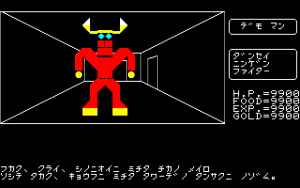- Ultima (Series Introduction)
- Akalabeth
- Ultima I: First Age Of Darkness
- Ultima II: Revenge of the Enchantress
- Ultima III: Exodus
- Ultima IV: Quest Of The Avatar
- Ultima V: Warriors of Destiny
- Ultima VII: The Black Gate
- Ultima VI: The False Prophet
- Ultima VII Part 2: Serpent Isle
- Ultima VIII: Pagan
- Ultima Underworld: The Stygian Abyss
- Ultima Underworld II: Labyrinth of Worlds
- Arx Fatalis
- Worlds of Ultima: The Savage Empire
- Ultima Worlds of Adventure 2: Martian Dreams
- Ultima IX: Ascension
- Lord of Ultima
- Ultima Online
- Ultima: Escape from Mt. Drash
- Ultima: Miscellaneous
- Richard Garriott (Interview)
The world rejoiced! A great hero had come from seemingly out of nowhere to battle the wizard lord Mondain and end his reign of terror forever! Now free from his legions of hideous monsters, the earth settles into a happy peace. But it is not to last, for the rule of Lord British has brought the kingdoms together under a common flag of fellowship and goodwill, and the happy people turn a deliberate blind eye to the hints of darkness on the horizon. The most wondrous discovery of the age, the shimmering Moongates through which a man may travel through space and time, had both created a new renaissance era of learning and opened the door for evil to again enter the world. The enchantress Minax, apprentice of Mondain, had built up her power by conquering the Time of Legends, and from the Moongates poured her minions to bring annihilation to the world. In the year 2111, civilization ended in a firey apocalypse; you only avoided it by being in transit in the past at the time. Now it falls to you to marshal your forces, gather resources, travel history, and defeat Minax!
Much like Phantasy Star III or Final Fantasy Mystic Quest, Ultima II is often seen as the black sheep of the series. While the graphics are similar to the first game, it plays very differently and the setting features an even more bizarre amalgamation of standard fantasy and science fiction traits, as well as a healthy sprinkling of references to pop culture, Richard Garriott’s real-life friends, and other video games. This is the only game in the Ultima series where the map is planet earth rather than the fictional land of Sosaria/Britannia, though this would later be retconned away into the game taking place in Sosaria. Garriott was heavily inspired by the Terry Gilliam film Time Bandits during the development, which adds greatly to the game’s flavor and general goofy tone. Features such as slipping between Earth’s timelines, the Timegate portals (later to be known as Moongates and a series staple element), and the strange dialogue and sense of humor are all fairly directly taken from the film, as well as the design of the game’s detailed cloth map.
You are dumped into North America in the 1400s and must quickly find a town to buy weapons, armor and food at before you are ravaged by random monsters, and then figure out how to reach Lord British’s Castle via the Moongates, portals which open only at certain times and which become a defining part of the Ultima series. Playing the game consists primarily of fighting monsters on the overworld to build up gold, which is spent to buy equipment, food, hit points and stat increases. Overworld monsters also randomly drop items, some of which are useless and some of which are vital to play, such as the ‘brass button’ that allows flying a plane, and ‘blue ribbon’ which allows the player to commandeer a pirate ship that will rarely appear on the coastlines. HP is increased through giving tribute to Lord British, and statistics are increased by offering gold to the clerk of the Hotel California in New San Antonio in 1990. Wandering the ravaged earth and fighting monsters allows you to gather necessary gear and enough gold to purchase stat increases, health and food, with the ultimate goal of becoming powerful enough to assault Minax and her armies of demons in the Time of Legends, preventing the future apocalypse and bringing Earth Sosaria out of the second Age of Darkness.
Ultima II was a critical darling on release, gathering glowing reviews from contemporary publications such as Computer Gaming World for greatly expanding the first game in the series. It was published by Ken and Roberta Williams’ Sierra On-Line after Ultima’s previous publisher, California Pacific Computer, went out of business. Several publishers approached Richard about the game, but he ultimately chose Sierra because they were the only ones who agreed to his preferred packaging and royalty demands. California Pacific had sold Akalabeth and Ultima in ziploc bag packaging with an insert, as was common with software of the era, but Garriott wanted for his next game a proper box, with high-quality manual and a cloth map of the game world. Ultima II is therefore the first game in the series to include ‘feelies’, additional materials or props packaged with the game; the term was coined by company Infocom for the supplemental materials included in their interactive fiction titles and widely used by gamers for other similar trinkets. High-quality cloth maps would be packaged with almost every Ultima from here on and become one of the series’ most recognizable features.
The success of Ultima II ultimately led to Garriott him dropping out of college to focus full-time on developing games. Ultima II was the only game in the series to be published by Sierra; disagreements resulted in Garriott founding a new company for his games starting with the next installment in the series. Sierra appears to have retained some publishing rights for a time, re-releasing the original Apple II Ultima in their own packaging for Apple II and Atari 400/800, and using the Ultima name for an unrelated dungeon-crawler, Escape from Mount Drash, which will be discussed in its own section later.
Unfortunately, Ultima II has aged very poorly compared even to its contemporaries. You spend a long time fighting monsters for gold and needed randomly-dropped gear, and it’s bloody frustrating having no control over when you get that ribbon needed to commandeer a ship, or the staff or wand needed to cast any magic. Experience points are gained after every slain monster but they appear to do absolutely nothing. Agility is the only stat that matters in the start of the game, and it’s easy to severely handicap yourself to the point of being unable to play by not putting enough points into it, since it governs the hit chance of attacks and your ability to steal. Having less than 20 makes it almost impossible to touch anything, and having to pay money for food instead of stealing it means money not going to more important things like hit points or stat increases. Since you’re wasting all your money replacing HP taken by monsters with dodging skills straight out of The Matrix, that means good luck getting any stronger. The dungeon-crawling of Akalabeth and Ultima I is still here, and dungeons provide an item necessary for using your spaceship, but this same item can also be found as a random drop, making dungeon-crawling a pointless waste of time. (A patch for the Apple II version of the game removes random drops of this item from the overworld, giving dungeon-crawling a purpose). Space travel itself allows the player to reach other planets in the solar system, and several have unusual landscapes or silly references and jokes. Richard’s father Owen Garriott can be found searching for his space shuttle, while Al and Margot Tommervik, the founders of influential Apple II magazine Softalk, can be visited in their headquarters. Only one planet really needs to be visited, though, and the rest are ultimately pointless, especially the many with nothing on them at all.
Revenge of the Enchantress was the first game in the series to be written in assembly language rather than Apple BASIC, which made it much easier to port and subsequently the first game in the series to see versions on computers other than the Apple II. In computer science, BASIC is a ‘high level’ language with a form designed to be similar to natural human language (like English) which converts to Assembly, a ‘low level’ form closer to the computer’s machine code of 0s and 1s. Coding in Assembly in the first place gives greater control and efficiency over exactly what your software does with a computer and so takes less processing power to run than high-level languages like BASIC, resulting in faster programs. Assembly languages are different for each variety of processor, and the C64, Atari 400/800 and Apple II all used similar processors from MOS Technology’s 6502 series, so only minor changes to the code would have been necessary to port the games. This also provides a possible explanation for why the Ultima games were never ported to 8-bit computers popular in Europe such as the ZX Spectrum and Amstrad CPC, which used totally different processors.
In addition to the original, versions of Ultima II are available for IBM PC, Atari 8-bit, Atari ST, Commodore 64, Macintosh, Fujitsu FM-77, NEC PC-88/PC-98 and MSX. There are several differences between the ports. Only the Apple II original and the Atari 8-bit port have the animated title screen with a dragon breathing fire. Charles Bueche’s Atari 8-bit version has less impressive color but is otherwise almost the same as the Apple II. The Commodore 64 port, done by an unknown person under the name ‘bobbit’, is visually distinct from the other game versions, with bright, crisp colors that lend the game a different feel. The Macintosh version of the game is a total rewrite that enhances the game to use the Macintosh GUI, complete with both mouse support and the addition of many menus, though it is colorless (Macintosh monitors of the time were monochrome). The Atari ST version written by Robert Heitman uses a strange color scheme which inverts the graphics, giving the game a very strange feel, but it is otherwise similar to the Macintosh version in integrating the game with the machine’s OS for a mouse-driven, menu-controlled interface. There are two DOS ports of Revenge of the Enchantress; the second, released on the various Ultima collections, removes all mention of Sierra On-Line from the title.
The Japanese versions were published by two different companies at different times, Star Craft and Pony Canyon, who handled them differently. Star Craft’s PC-88, PC-98 and FM-7 ports are mostly straight ports of the Apple II and not terribly different from it, while later Pony Canyon releases on PC-88, PC-98 and MSX2, like their Ultima I version, use a completely new, brightly-colored and anime-ish tileset and original music score. Fujitsu’s FM Towns release comes once again only as part of a special edition Ultima Trilogy collection with enhanced graphics and each with detailed introduction movies.
Jay Sullivan’s IBM PC port of Ultima II is worth special mention because of several severe problems with this version, mostly the result of the technical limitations of IBM’s personal computers, which were originally built as business and not gaming machines. The graphics use the four-color CGA standard and are intended for a CGA composite monitor, which would display colors similar to the Apple II original. On any other sort of monitor, which players then and now are overwhelmingly likely to be using, the game instead uses an ugly magenta/teal/purple color scheme which is hard on the eyes. There are multiple glitches introduced into this version of the game, including the lack of a frame-limiter (making the game unplayable without the ability to slow your CPU on Windows, or throttling your CPU emulation in Dosbox) and the potential for a divide-by-zero error which will freeze the program. Most importantly, CD releases of Ultima II for DOS, such as the version on EA’s Gold Classics collection, have a game-breaking bug where the maps for various planets are not available. This is due to different files having identical filenames on the original two-disk version of the game; when the files are on a single CD, one set overwrites the other. Problems with the IBM PC version of Ultima II can be alleviated via a fan-made patch, which restores the missing maps, adds 16-color EGA graphics, enables a frame limiter and fixes some bugs, among other features. With the upgrade patch, the IBM PC version of Ultima II becomes the definitive for English speakers. Unfortunately, the patch requires finding a copy of csdpmi5b.zip and the patcher executable will not work in 64-bit versions of Windows. Using Windows XP mode of Windows 7’s Virtual PC feature will allow you to run the patcher, and various mirrors of the necessary dpmi files can be found on the internet.
Early in 2011, a small programming group in Paris, France called Brutal Deluxe Software was working with Rebecca Heineman to create a new Apple IIGS port of Ultima II based on the code of the Apple IIGS Ultima I. This version unfortunately doesn’t seem likely to ever be completed and released, due to steep licensing fees from current copyright holders Electronic Arts.
Links:
Ultima II fan upgrade patch
Mobygames entry for Ultima II: The Revenge of the Enchantress
Walkthrough and game help on the Ultima Web Archive.
An entertaining review of the game from a modern gamer’s perspective.
RPG Shrine for Ultima II
Purchase the Age of Darkness trilogy at Gog.com
Comparison Screenshots
Additional Screenshots – FM Towns
